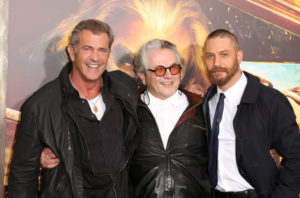 With George Miller’s announcement of three more Mad Max films on their way, I began to reminisce about the four films that have been released so far. Three of them star Mel Gibson as Max Rockatansky and one stars Tom Hardy as Max…sort of. In reality, there was very little of Mad Max in Mad Max: Fury Road, and Hardy as Max didn’t end up doing a whole lot, considering the movie is named after him.
With George Miller’s announcement of three more Mad Max films on their way, I began to reminisce about the four films that have been released so far. Three of them star Mel Gibson as Max Rockatansky and one stars Tom Hardy as Max…sort of. In reality, there was very little of Mad Max in Mad Max: Fury Road, and Hardy as Max didn’t end up doing a whole lot, considering the movie is named after him.
In reality, the movie was not a Mad Max movie at all. It was a Furiosa movie. Max’s almost cameo appearance was for show, not substance. Let’s examine the four films and compare them.
Mad Max
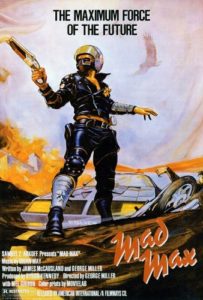 Way back in 1979 no one heard of the existence of an action hero named Mad Max. Nor was the world familiar with a young, freshly-scrubbed screen face called Mel Gibson. The world was new back then, and apocalyptic movies were not a dime a dozen like they are today. Mad Max was inspired by director George Miller’s experiences as an emergency room doctor. He took the carnage he’d witnessed in the ER and splashed it all over the silver screen.
Way back in 1979 no one heard of the existence of an action hero named Mad Max. Nor was the world familiar with a young, freshly-scrubbed screen face called Mel Gibson. The world was new back then, and apocalyptic movies were not a dime a dozen like they are today. Mad Max was inspired by director George Miller’s experiences as an emergency room doctor. He took the carnage he’d witnessed in the ER and splashed it all over the silver screen.
Oddly, the doctor went to film school one summer and encountered Byron Kennedy. They worked together to make a short film called Violence in the Cinema, Part 1 that won several awards in the film festival circuit. Several years later they teamed up with first-time screenwriter James McCausland to make a feature film, produced by Kennedy, inspired by the ER carnage plus the extreme behavior of Australians dealing with the oil shortage back in those days. Director Miller wanted a film that told the bulk of its story through actions and images rather than words.
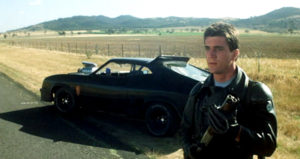 One of the critical needs was to cast the actor for Max. Miller first wanted an American actor to generate more interest for the US market, but quickly realized their asking price would bust his budget. So he hosted a cattle call of Australian actors, looking for an unknown that wouldn’t bring baggage to the role. Along came National Institute of Dramatic Art graduate Mel Gibson with one small film under his belt. Gibson impressed director and casting director and got the part, along with his buddy and classmate Steve Bisley that landed the role as Max’s buddy and copmate Jim Goose.
One of the critical needs was to cast the actor for Max. Miller first wanted an American actor to generate more interest for the US market, but quickly realized their asking price would bust his budget. So he hosted a cattle call of Australian actors, looking for an unknown that wouldn’t bring baggage to the role. Along came National Institute of Dramatic Art graduate Mel Gibson with one small film under his belt. Gibson impressed director and casting director and got the part, along with his buddy and classmate Steve Bisley that landed the role as Max’s buddy and copmate Jim Goose.
 Another critical casting choice was the villain, Toecutter. India-born Hugh Keays-Byrne was chosen. As a child, his family moved to England where he ended up building a career as a Shakespearian stage actor. He toured with the Royal Shakespearean Company to Australia and ended up staying there, making television and film appearances. It was there he struck worldwide fame delivering a whirlwind performance in the role of Toecutter, as creepy a villain as you could ask for. (This would not be the only time he’d grace a Mad Max screen.) Toecutter’s minions are played by members of an actual outlaw biker gang in Australia who rode their own cycles for the film.
Another critical casting choice was the villain, Toecutter. India-born Hugh Keays-Byrne was chosen. As a child, his family moved to England where he ended up building a career as a Shakespearian stage actor. He toured with the Royal Shakespearean Company to Australia and ended up staying there, making television and film appearances. It was there he struck worldwide fame delivering a whirlwind performance in the role of Toecutter, as creepy a villain as you could ask for. (This would not be the only time he’d grace a Mad Max screen.) Toecutter’s minions are played by members of an actual outlaw biker gang in Australia who rode their own cycles for the film.
For those living under a rock, Mad Max is the story of a highway patrol cop named Max who fights to maintain a semblance of order on the wild highways of post-apocalyptic Australia. He’s a kickass “bronze” as they’re called, but also has a loving, tender side to him with a sweet family including a wife and toddler son. He fears the harsh life on the highways is making him as crazy as the vermin out there, so he takes leave and travels with his family to a relative. But the vermin catch up with him and cause horrific mayhem that drives him to a fury that earns him the moniker “Mad Max.”
This clip, obviously a huge spoiler since it’s the ending, shows the austere intensity of the drama in this film.
It’s Mel Gibson’s break-out role that made him a worldwide name, so you can blame Miller and Kennedy for that. For me, it’s a good thing because I’m mature enough to distinguish between a person’s artistic work and their personal lives, unlike many losers trolling the Internet. Gibson has been a towering actor and film maker, and I’d hate to think of a world where he remained an obscure nobody.
When Mad Max was released in the USA, the foolish distributors American International thought Americans couldn’t handle the Australian accents, so they dubbed all the dialog in American. Thankfully, after decades, the original Autralian soundtrack was released in the USA, and only then was I willing to purchase my own disk of the film. Mad Max is classic independent exploitation action cinema, yet it rises above the usual fare with some serious characterization with a hero who has a well-rounded life before tragedy strikes. Plus, it’s an absolute requirement to view the origins of Max before moving on to the bigger sequels.
Mad Max 2 AKA The Road Warrior
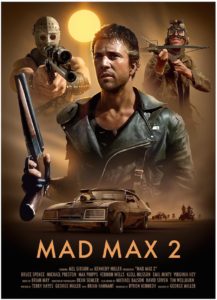 Mad Max hit the Guiness book of records for most profitable film to date, so of course a sequel was in order, which came out two years later. Miller was excited to have a bigger budget so he could do a better job. And he certainly did.
Mad Max hit the Guiness book of records for most profitable film to date, so of course a sequel was in order, which came out two years later. Miller was excited to have a bigger budget so he could do a better job. And he certainly did.
It was named simply Mad Max 2, but again, the distributors felt like Americans needed something different. This time it was Warner Brothers, who didn’t think the original Mad Max was popular enough, so they released the second film in the USA as The Road Warrior. The marketing made absolutely no connection to the original film.
 Road Warrior is one of those rare sequels that transcend the first film. It takes everything great about the original and doubles it. I consider this film to be a near-perfect film in writing, in plot, in characterization. It’s a wild action ride with tight storytelling, yet is a case study in how to show characterization through an economy of techniques that never interrupt the action. Mel Gibson reappears as Mad Max, including his Australian accent, which we still don’t hear often because the dialog is as sparse as with the original.
Road Warrior is one of those rare sequels that transcend the first film. It takes everything great about the original and doubles it. I consider this film to be a near-perfect film in writing, in plot, in characterization. It’s a wild action ride with tight storytelling, yet is a case study in how to show characterization through an economy of techniques that never interrupt the action. Mel Gibson reappears as Mad Max, including his Australian accent, which we still don’t hear often because the dialog is as sparse as with the original.
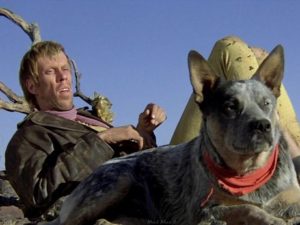 The characters are even more vivid with this incarnation. Max has become an aimless and nomadic lost soul living from meal to meal and fuel tank to fuel tank. He encounters a comical figure of a man known as the Gyro Pilot, played by Bruce Spence, who owns a gyrocopter—basically a helicopter reduced to its bare minimum. Max threatens him, and the pilot, to spare his life, tells him where unlimited fuel is. Max takes him along as a prisoner instead.
The characters are even more vivid with this incarnation. Max has become an aimless and nomadic lost soul living from meal to meal and fuel tank to fuel tank. He encounters a comical figure of a man known as the Gyro Pilot, played by Bruce Spence, who owns a gyrocopter—basically a helicopter reduced to its bare minimum. Max threatens him, and the pilot, to spare his life, tells him where unlimited fuel is. Max takes him along as a prisoner instead.
A wide cast of characters then opens up consisting of two groups.
 The first is a civilized group who’ve commandeered a single oil pump to process enough fuel to escape the “Wasteland,” the name of the expansive desert in post-apocalyptic Australia. They are led by a visionary man named Papagallo, who is heroic and principled and cares for his people.
The first is a civilized group who’ve commandeered a single oil pump to process enough fuel to escape the “Wasteland,” the name of the expansive desert in post-apocalyptic Australia. They are led by a visionary man named Papagallo, who is heroic and principled and cares for his people.
 The other group is the Marauders, a wild gang under the command of Lord Humungus, who is every bit as colorful and creepy a villain as the Toecutter. He wears a hockey mask over his head, with fleeting hints that he does so because he’s been severely burned or something. One of his many titles is the “Ayatollah of Rock and Rollah,” which his crier Toadie enthusiastically announces. This group lusts after the “fat tank” of fuel and continually attack to possess it.
The other group is the Marauders, a wild gang under the command of Lord Humungus, who is every bit as colorful and creepy a villain as the Toecutter. He wears a hockey mask over his head, with fleeting hints that he does so because he’s been severely burned or something. One of his many titles is the “Ayatollah of Rock and Rollah,” which his crier Toadie enthusiastically announces. This group lusts after the “fat tank” of fuel and continually attack to possess it.
Max weasels his way in with Papagallo’s group and bargains with them for some fuel. He knows about a semi tractor he can bring to them to haul the tanker away. He delivers, and they outfit him with as much fuel and supplies as he can carry.
This is when the movie wowed me even beyond how much it already did to this point. The film pulls no punches for our hero, following the storytelling edict to show no mercy to one’s protagonist. All seems lost, and Max’s efforts to survive change him from the soulless shell of a man he was after the first movie into something with humanity again.
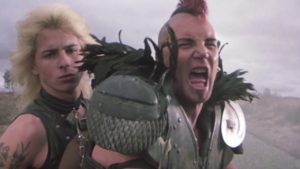 One of the greatest villains in this film is a soldier of Humungus named Wez, a striking mohawked figure with buttcheeks hanging out and a blind gay lover. Wez is played by Vernon Wells, who essentially reprises his roll for laughs as a post-apocalyptic mutant in the John Hughes film Weird Science. But in Road Warrior, Wez is no laughing matter. He’s a vicious, serious threat that takes Max’s interference personally. Empire magazine calls him the greatest cinematic henchman of all time.
One of the greatest villains in this film is a soldier of Humungus named Wez, a striking mohawked figure with buttcheeks hanging out and a blind gay lover. Wez is played by Vernon Wells, who essentially reprises his roll for laughs as a post-apocalyptic mutant in the John Hughes film Weird Science. But in Road Warrior, Wez is no laughing matter. He’s a vicious, serious threat that takes Max’s interference personally. Empire magazine calls him the greatest cinematic henchman of all time.
 Among Papagallo’s people is the Feral Kid, one more colorful character who never utters a word but is prone to growls and grunts like a beast. He’s a delightful addition that could easily have been overlooked during the writing, but adds a charming touch to the film and some humanity to Max. His razor-sharp boomerang also provides an appealing and original element.
Among Papagallo’s people is the Feral Kid, one more colorful character who never utters a word but is prone to growls and grunts like a beast. He’s a delightful addition that could easily have been overlooked during the writing, but adds a charming touch to the film and some humanity to Max. His razor-sharp boomerang also provides an appealing and original element.
Road Warrior turns the highway conflict of vehicles in Mad Max from a skirmish to an all-out battle. It’s a masterful work of cinematic storytelling that every film student should study. Roger Ebert called it “one of the most relentlessly aggressive movies ever made.” I consider it the best of all four Mad Max films. It set the stage for the look of many post-apocalyptic films to come.
Mad Max Beyond Thunderdome
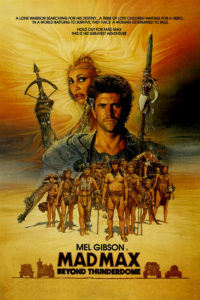 Road Warrior earned financial success and critical acclaim and started the mythologizing of Mad Max as a character. This opened the gate for a third film, and Beyond Thunderdome pulled out all the production stops. It replaces the raw independent feeling of the first two films with Hollywood gloss and a Hollywood budget, and the unknown actors with some big names.
Road Warrior earned financial success and critical acclaim and started the mythologizing of Mad Max as a character. This opened the gate for a third film, and Beyond Thunderdome pulled out all the production stops. It replaces the raw independent feeling of the first two films with Hollywood gloss and a Hollywood budget, and the unknown actors with some big names.
I’m a little embarrassed to admit that I never heard of Mad Max until marketing for Beyond Thunderdome came out in 1985. It looked intriguing, but I discovered that there were two movies that came before it. No way was I going to watch number three before seeing numbers one and two, so I promptly rented the first two, and my family was introduced to Mad Max.
I thought the first film was fascinating but quirky and definitely smacked of low budget independent film. By the end of the second film, I was a Mad Max fan through and through and couldn’t wait to see the third one in theaters. That one proved to be something very different, yet very familiar to the Mad Max mythos.
 Mel Gibson returns for the last time as Max, and excels at representing both his dark side and his humanitarian side in the same austere style of few words and volumes spoken with a simple expression. He’s a big name actor by this point, and he’s joined by other big names fitting of the Hollywood level of this production.
Mel Gibson returns for the last time as Max, and excels at representing both his dark side and his humanitarian side in the same austere style of few words and volumes spoken with a simple expression. He’s a big name actor by this point, and he’s joined by other big names fitting of the Hollywood level of this production.
The character of Max transcends being a human in this film. He becomes an out-and-out mythic character, the archtypical lone hero that saves people but never seems to find happiness himself.
 Appearing with him is the antagonist—not exactly a villain—named Aunty Entity. The incomparable Tina Turner is cast in this role, and she shows that her acting chops are fantastic, easily able to hold her own with veteran Gibson. She plays the role with charm and flamboyance and pizazz, and we believe to the bone that she could command an entire post-apocalyptic town of hooligans. Not only does she deliver on her acting, but we’re graced with her magificent voice belting out two stirring songs, one at the beginning and one at the end like bookends.
Appearing with him is the antagonist—not exactly a villain—named Aunty Entity. The incomparable Tina Turner is cast in this role, and she shows that her acting chops are fantastic, easily able to hold her own with veteran Gibson. She plays the role with charm and flamboyance and pizazz, and we believe to the bone that she could command an entire post-apocalyptic town of hooligans. Not only does she deliver on her acting, but we’re graced with her magificent voice belting out two stirring songs, one at the beginning and one at the end like bookends.
 Along with Turner is another distinguished actor who is well-known for playing Pontius Pilate in Charlton Heston’s Ben-Hur. Frank Thring gives us a great performance in that classic film, and does no less for Thunderdome, playing the Collector who is Aunty’s right hand man in governing Bartertown. He brings a jaded cynicism to his character that is pitch perfect, and his impactful classic voice adds a welcome gravitas.
Along with Turner is another distinguished actor who is well-known for playing Pontius Pilate in Charlton Heston’s Ben-Hur. Frank Thring gives us a great performance in that classic film, and does no less for Thunderdome, playing the Collector who is Aunty’s right hand man in governing Bartertown. He brings a jaded cynicism to his character that is pitch perfect, and his impactful classic voice adds a welcome gravitas.
 Another accomplished actor appearing in Thunderdome is Angelo Rossitto, a small person who’s appeared in dozens of films, most notably as the evil dwarf right-hand man to Mr. Dark in Something Wicked This Way Comes. He owns every scene he appears in playing the Master half of Master Blaster, one of the most original antagonist characters ever devised. With his broken English, he oozes malicious power, yet later transforms into a respectable individual in a tweed suit.
Another accomplished actor appearing in Thunderdome is Angelo Rossitto, a small person who’s appeared in dozens of films, most notably as the evil dwarf right-hand man to Mr. Dark in Something Wicked This Way Comes. He owns every scene he appears in playing the Master half of Master Blaster, one of the most original antagonist characters ever devised. With his broken English, he oozes malicious power, yet later transforms into a respectable individual in a tweed suit.
 Other colorful characters make appearances. Dr. Dealgood is creepiness embodied, a kind of game show host from hell. He delivers a delightful speech introducing the Thunderdome that is magnificent and chilling. The titular Thunderdome acts a a sort of character all by itself and is one of the coolest concepts ever in post-apocalyptic science fiction.
Other colorful characters make appearances. Dr. Dealgood is creepiness embodied, a kind of game show host from hell. He delivers a delightful speech introducing the Thunderdome that is magnificent and chilling. The titular Thunderdome acts a a sort of character all by itself and is one of the coolest concepts ever in post-apocalyptic science fiction.
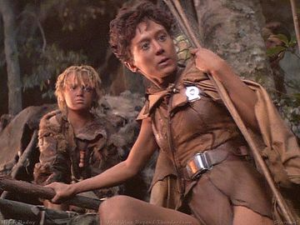 There are the children, a sort of more civilized Lord of the Flies society of youth abandoned in an oasis chasm in the gulag when families flee the nuclear devastation that created the post-apocalyptic world of Mad Max. The most prominent is Savannah Nix, who regales us with a mythologized history of how they got there. When Max discovers them, he’s mistaken for their savior in the mythology, Captain Walker.
There are the children, a sort of more civilized Lord of the Flies society of youth abandoned in an oasis chasm in the gulag when families flee the nuclear devastation that created the post-apocalyptic world of Mad Max. The most prominent is Savannah Nix, who regales us with a mythologized history of how they got there. When Max discovers them, he’s mistaken for their savior in the mythology, Captain Walker.
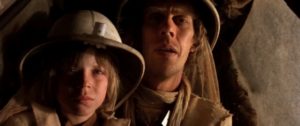 And there’s Jedediah the Pilot, a confusing character because he’s played by Bruce Spence, who plays the Gyro Captain in Road Warrior. He and his son are the first faces we see in Thunderdome, piloting a flying machine—this time an abbreviated airplane. My entire family assumed he was supposed to be the same character brought over from the second film, and it took me most of the movie to figure out that, no, he was not the same character. This inevitably leads to confusion, using the same actor for two different characters that both pilot a flying machine, and I’m surprised it never occurred to Miller or anyone else that such confusion would exist.
And there’s Jedediah the Pilot, a confusing character because he’s played by Bruce Spence, who plays the Gyro Captain in Road Warrior. He and his son are the first faces we see in Thunderdome, piloting a flying machine—this time an abbreviated airplane. My entire family assumed he was supposed to be the same character brought over from the second film, and it took me most of the movie to figure out that, no, he was not the same character. This inevitably leads to confusion, using the same actor for two different characters that both pilot a flying machine, and I’m surprised it never occurred to Miller or anyone else that such confusion would exist.
One of my favorite things about the movie is the cinematography. The camera almost never stands still. Its movements are sweeping, including long, complex shots, that provide an energy and dimensionality to the film. The camera weaves in and out of the action. The Thunderdome sequence is captivating in no small part because of the camera work.
The story is a smorgasbord of motifs, mashing together popular action and post-apocalyptic concepts into a coherent, engrossing, unexpected story. It takes the viewer on a ride all over the place and ends up in the signature Mad Max pursuit of vehicles, this time with a train included. I love watching the film over and over. It’s well done, yet still does not surpass Road Warrior because its story wanders all over the place instead of being a tight, carefully crafted tale. The economy of storytelling through images and actions and sparse dialog doesn’t carry over to this third installment. The story is less gritty, more surreal. None of this is a negative reflection on the film. It’s simply a differently told story from the other two Mad Max films.
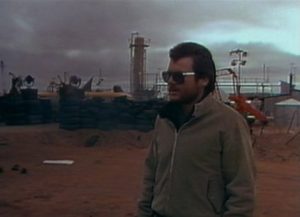 While scouting locations for the film in a helicopter, producer Byron Kennedy was killed in a crash. Miller questioned whether he wanted to continue without his partner, but in the end decided he had to complete the film in honor of his colleague. The film is dedicated to him with the words “For Byron.”
While scouting locations for the film in a helicopter, producer Byron Kennedy was killed in a crash. Miller questioned whether he wanted to continue without his partner, but in the end decided he had to complete the film in honor of his colleague. The film is dedicated to him with the words “For Byron.”
With the rolling of credits at the end of this film, the Mad Max franchise comes to an end. Mel Gibson will never be seen as Max Rockatansky again.
Mad Max: Fury Road
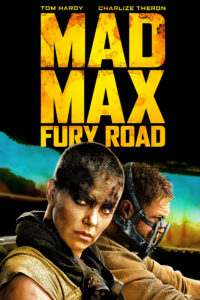 Some, probably most, will object to my saying Mad Max has come to an end. Some might say Mad Max is more alive than ever. Surely the existence of this fourth installment proves me wrong.
Some, probably most, will object to my saying Mad Max has come to an end. Some might say Mad Max is more alive than ever. Surely the existence of this fourth installment proves me wrong.
These people are mistaken.
Technically, of course, they’re not mistaken. Technically there is a fourth Mad Max film. It says so right in the title. But for all practical purposes, this is no Mad Max film at all.
First of all, Mel Gibson is nowhere to be found. How can you have a Mad Max movie without Mel Gibson? You might as well have an Indiana Jones movie without Harrison Ford.
 Tom Hardy makes a heroic effort being Max, but he’s severely restricted by the simple fact that he doesn’t have much screen presence throughout the film, and even when he does, there’s little for him to do. He’s almost an afterthought, thrown in for the marketing advantages of calling the film “Mad Max.”
Tom Hardy makes a heroic effort being Max, but he’s severely restricted by the simple fact that he doesn’t have much screen presence throughout the film, and even when he does, there’s little for him to do. He’s almost an afterthought, thrown in for the marketing advantages of calling the film “Mad Max.”
 No, this is no Mad Max film. This is a Furiosa film, through and through. There’s nothing about the film that has the feel of a Mad Max movie. It has no more the spirit of Mad Max than J.J. Abrams’ Star Trek movies have the spirit of Star Trek. Like J.J.’s films, Fury Road is all glitz and no substance. Almost no story, almost no characterization. Just lots of visual shiny pennies to dazzle the YouTube generation into thinking it’s a great film. I mean, what self-respecting teen wouldn’t feel like he’s died and gone to heaven watching a movie with an electric guitar that shoots flames?
No, this is no Mad Max film. This is a Furiosa film, through and through. There’s nothing about the film that has the feel of a Mad Max movie. It has no more the spirit of Mad Max than J.J. Abrams’ Star Trek movies have the spirit of Star Trek. Like J.J.’s films, Fury Road is all glitz and no substance. Almost no story, almost no characterization. Just lots of visual shiny pennies to dazzle the YouTube generation into thinking it’s a great film. I mean, what self-respecting teen wouldn’t feel like he’s died and gone to heaven watching a movie with an electric guitar that shoots flames?
The original Mad Max films attempted to remain somewhat grounded in reality within the context of being a post-apocalyptic science fiction world. Fury Road is pure surrealistic indulgence, a 21st century grab bag of cool images and actions that mean nothing. There’s nothing about it that attempts to be even marginally realistic. It continues the trend in Hollywood of trivializing everything into flash without substance. Whereas the highway chase scenes in the first three films serve the story, the chase scenes in the fourth film are the story. There is no more story than that.
Even if it were a good film, which it’s not from a storytelling perspective, it’s still not a Mad Max film. It’s 100% Furiosa’s film, and in the end she is the triumphant protagonist. Max is just along for the ride, dabbling in a bit of conflict here and there.
There should have been a true Mad Max sequel, and Fury Road should have been a spin-off film introducing Furiosa as a new character in the Mad Max universe. That film wouldn’t have needed Max at all.
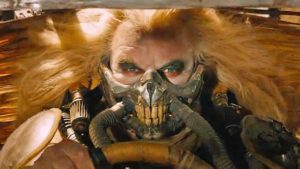 The one cool non-shiny-penny thing about the film is how they brought back the actor who played Toecutter in the original film. Hugh Keays-Byrne plays Immortan Joe, the even more creepy villain with an unforgettable breathing mask. That’s a fun thing to do, but Joe ends up being just as outlandishly unrealistic as the rest of the film. I can imagine Toecutter or The Humungus being real people in a world of the future, but in no real world can I imagine a villain existing on the order of Immortan Joe. He’s simply too comic-bookesque.
The one cool non-shiny-penny thing about the film is how they brought back the actor who played Toecutter in the original film. Hugh Keays-Byrne plays Immortan Joe, the even more creepy villain with an unforgettable breathing mask. That’s a fun thing to do, but Joe ends up being just as outlandishly unrealistic as the rest of the film. I can imagine Toecutter or The Humungus being real people in a world of the future, but in no real world can I imagine a villain existing on the order of Immortan Joe. He’s simply too comic-bookesque.
Is There Hope for Mad Max in the Future?
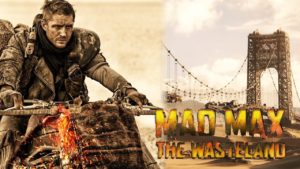 Three more sequels are supposed to be on their way. Word is, two of them will focus on Max and one on Furiosa, as it should be. But after experiencing such disappointment with Fury Road while the rest of the world was bedazzled to a hysteria over the flash and glitz, caring nothing about the utter absence of a story, I fear how these three films will turn out. Miller’s Fury Road won six Oscars and garnered lots of money and critical acclaim. There’s no motivation for him to do anything different next time.
Three more sequels are supposed to be on their way. Word is, two of them will focus on Max and one on Furiosa, as it should be. But after experiencing such disappointment with Fury Road while the rest of the world was bedazzled to a hysteria over the flash and glitz, caring nothing about the utter absence of a story, I fear how these three films will turn out. Miller’s Fury Road won six Oscars and garnered lots of money and critical acclaim. There’s no motivation for him to do anything different next time.
 By the way, none of those six Oscars had anything to do with the storytelling aspect of the movie. Only with the glitz:
By the way, none of those six Oscars had anything to do with the storytelling aspect of the movie. Only with the glitz:
Film Editing
Costume Design
Makeup and Hairstyling
Sound Mixing
Sound Editing
Production Design
I fear I may have to resign myself to the fact that there are and ever will be only three true Mad Max movies, just like I’ve resigned myself to the fact that there are only three true Star Wars movies, two true Terminator and Alien and Godfather movies, and after the series Enterpise was cancelled, no true Star Trek ever to come again.
I’d love for George Miller to prove me wrong.